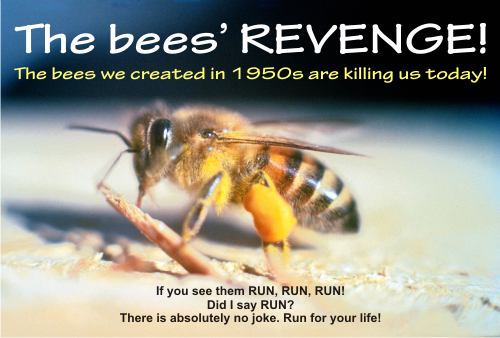We know that in a hive, bees have different jobs, that resemble our regular human jobs. Some are harvesting for nectar or pollen, some are nursing the babies, some are cleaning the hive, some are building, while some are guarding it.
What do guard bees do?
Just like any bodyguard in a store, they guard the hive. There are plenty of enemies threatening the bees, their food supply, and their babies. Their job is not easy at all.
At what age do bees become guardians?
From day 18 to day 21, bees are guarding the hives. As human correspondence, this is the equivalent of our 30s, a period in which we are full adults, strong and bold.
How many guard bees protect the hive?
In a strong colony there are about ten to twenty guard bees at a time, that patrol the entrance of the hive. Weaker colonies may not have any guard bees at the entrance, other jobs are prioritar and their efforts are concentrated on them.
But when the threaten is really big, the guards use an an alarm pheromone, thus calling for reinforcements. All worker bees will respond to the call and they all will protect the hive with the price of their lives.
Who are the enemies of honey bees in the hive?
I know the first thought is humans. But I’ll exclude them for now, there is no match for humans, so I’ll move over.
1. Robber bees, which are bees from other colonies, trying to infiltrate inside the hive and steal the already made honey.
2. Ants, moths and wasps (yellow jackets). These generally make the most common enemy for a hive, and they bring the guardian bees a lot of trouble.
How do guard bees protect the hive from ants?
Do they bite them? Sting them? Push them outside?
More, the latter. They are fanning their wings and blow ants away. No necessary harm is done.
Ants invade honey bees hive trying to steal honey, prey on their eggs or and kill the worker bees in the fight. On 18 July 2024, Carolyn Wilke published a study in newscientist.com, on how Japanese honeybees flutter their wings and tilt their bodies to beat away their enemies. See in the video below.
As for the wasps, honey bees have an incredible strategy of suffocating them, that you can find described in detail here: Japanese Honeybees vs Giant Hornet
3. Mice. Yes, mice love honey. They also take refuge inside a beehive, but treating themselves with honey is something no mouse can refuse.
See how a mouse almost destroyed the hive in this video:
4. Skunks, raccoons, opossums, honey badgers and even some bird species.
Shunks try to avoid the guard bees and seek for the hive with fewer guards, or none. Which means smaller colonies. They had been seen moving up and down among the beehives of an apiary, until they find one with only one bee guardian at a time at the entrance. Now they dare to rob the honey.
Roger Morse describes the shunks endeavor to feed themselves on honey bees and their honey:
Skunks usually feed on bees at colony entrances late in the evening. They walk up to an entrance, scratch on it, and when bees come out to investigate, the skunks swat them, usually stunning them, and eat them.
The grass in front of hives where skunks feed is torn up and mud is usually visible on the hives. This is caused by skunks scratching themselves and their surroundings when they are stung.
Skunks feeding on bees have been dissected and stings have been found in their mouths, esophagi, and stomachs; these stings do not deter the skunks from feeding. Observers report that mother skunks may teach their young to feed at beehives. – from the book A Year in the Beeyard by Roger Morse (the link leads you to Amazon where you can find the book).
Raccoons are well-known for destroying the hives and eating the honey.
Opossums are just like skunks. They are North American marsupials that prefer feeding more on the honeybees themselves then on honey. However, they will empty the hive completely! No evidence left behind!
Honey badgers, also known as ratels, have been named like that because of their love for honey. Actually, for the entire beehive, with everything inside of it.
They are led to the hives by their friends in crime, the birds called Greater Honeyguides, which guide the honey badgers to the hives. The badgers break the hive and eat the inside, leaving some scraps for their guiding partners.

5. Bears. We know bears love honey. It is true that over winter they lack food and so they come to borrow from neighbors. Winnie the Pooh’s obsession with honey was not invented, was inspired from its real kins.
Read this page to understand Why do bears like honey and my cat doesn’t?
Are foraging honey bees safe from predators?
Definitely not. Despite their sting and their mouth also used to bite, there are predators such as birds, frogs, spiders and assassin bugs that can capture and feed on foraging honey bees.
No matter their jobs, bees don’t have an easy life, that’s for sure.
Do wild bees have guard bees and protect their nests in the same way?
They do. We call them soldiers bees.
An article from 2012 published by The Guardian, showed that Jatai bees are the first known bee species to have a specialized soldier class to protect their colony.
The soldier bees are larger and 30% heavier than other worker bees and defend the entrance. They hav been identified in colonies of a Brazilian stingless bee known as a Jatai, forming colonies of 10,000 individuals, in cavity walls, tree trunks or in the ground.
Soldier bees stand on the tube leading to the entrance of their nest to provide early warning of attack by robber bees. Unlike guard bees in honeybee colonies, they are physically specialized to perform the task of protecting their nest mates.
References:
https://cales.arizona.edu/pubs/insects/ahb/lsn27.html#:~:text=Skunks%20prefer%20to%20feed%20on,a%20time%20at%20the%20entrance.
https://www.manukahoneyusa.com/blog/5-animals-that-love-raw-honey.html#:~:text=Unsurprisingly%2C%20raccoons%20are%20known%20for,for%20destroying%20hives%20for%20it.
https://www.newscientist.com/article/2439789-watch-bees-defend-their-nest-by-slapping-ants-with-their-wings/
https://www.theguardian.com/science/2012/jan/09/soldier-bees-guard-nest-robbers#:~:text=The%20new%20research%20shows%20that,of%20protecting%20their%20nest%20mates.



